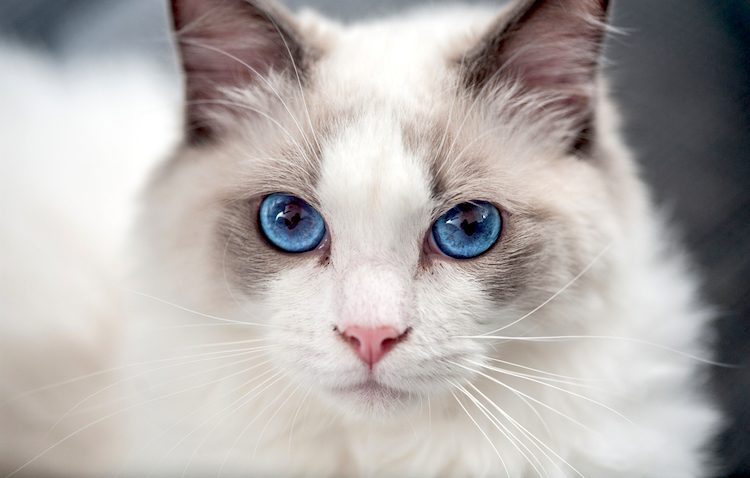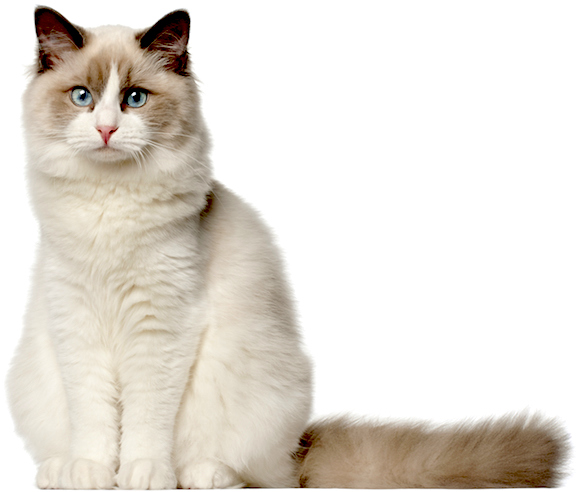
1. Key Characteristics of Ragdoll Cats
- Weight: 15–20 pounds for males, 10–15 pounds for females
- Life Expectancy: 15–20 years, on average (if kept indoors)
Ragdolls are large cats, one of the largest cat breeds.
They have a sturdy build and large blue eyes. The medium-length coat is pointed. Their body is lighter in color than the face, legs, tail and ears.
A Ragdoll’s soft and silky hair comes in 3 patterns: colorpoint (no white), bicolor and mitted.
Coat colors include chocolate, seal, blue, fawn, cinnamon, lilac, cream and red. There are also tortoiseshell or tabby variations.
2. Where Ragdoll Cats Came From
The Ragdoll cat breed began in Riverside, California, in the 1960s.
Ann Baker had a domestic, longhaired white cat named Josephine. The cat had normal litters of kittens — until, one day, she was hit by a car.
Baker insisted that Josephine’s genes were altered when she received veterinary care because her later litters had personalities described as limp and more affectionate in comparison to her earlier kittens.
Baker’s eccentricity over the years became too much for the breeders who franchised under her to produce Ragdolls, so breeders Denny and Laura Dayton broke off and sought to preserve the affectionate cats.
They were credited with getting the Ragdoll cat breed recognized by all major cat breed registries.

3. How Friendly Are Ragdoll Cats?
Ragdoll cats are so named because of their ability to lie limp or completely relaxed when they are picked up, similar to carrying a doll.
They are usually relaxed, happy, friendly, quiet and loving cats who enjoy cuddling. They are tolerant of other animals and children.
They are intelligent, too — you can teach Ragdolls to fetch and to come to you on command.
Always willing to play, they often act similar to dogs in the way they greet you at the door or follow you from room to room throughout the house.
4. Is This the Right Cat for You?
Exercise Needs
MEDIUM: Most Ragdolls enjoy playing fetch, similar to Russian Blue and Manx cats. Give them a scratching post and keep them indoors.
Regulate their food intake. Obesity may be a problem with these cats.
Ragdolls don’t have specific exercise needs in addition to those of regular cats.
Was YOUR Pet Food Recalled?
Check Now: Blue Buffalo • Science Diet • Purina • Wellness • 4health • Canine Carry Outs • Friskies • Taste of the Wild • See 200+ more brands…

Grooming Needs
MEDIUM: Brush or comb your Ragdoll weekly with a steel comb. They don’t shed much, except perhaps during spring and fall, when you should brush them more to prevent matting, especially where the legs meet the body.
Note that Ragdolls who are spayed or neutered may not have significant fluctuations in shedding or coat changes.
As with all cats, trim the nails and brush their teeth regularly. Bathe your Ragdoll, check and clean their ears regularly, and use separate cloths to clean each eye to reduce the risk of spreading infection.
Health Problems
MEDIUM: Common health problems that appear in Ragdolls cats include:
- Hypertrophic cardiomyopathy (heart disease)
- Bladder stones
- Feline infectious peritonitis
- Feline mucopolysaccharidosis (a disease that can cause eye problems, joint difficulties or paralysis)
You might be able to test your Ragdoll for some of these conditions.
Ragdoll cats can also experience growth spurts, so keep food available at all times until they reach maturity (around 4 years old).
This video shows a Ragdoll cat being held and going limp, something they are known for and named after:

5. Where to Adopt a Ragdoll Cat
Purebred cats end up in shelters and rescues all the time. Check these resources first, and you can also use our adoptable pet page.
If you decide to contact a breeder, get to know the breeder before choosing a Ragdoll kitten or cat. Be aware of the warning signs of kitten mills.
Ask the breeder to provide health certificates, clearances or test results for the health conditions that normally affect Ragdoll cats.



